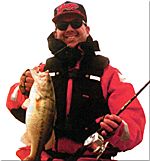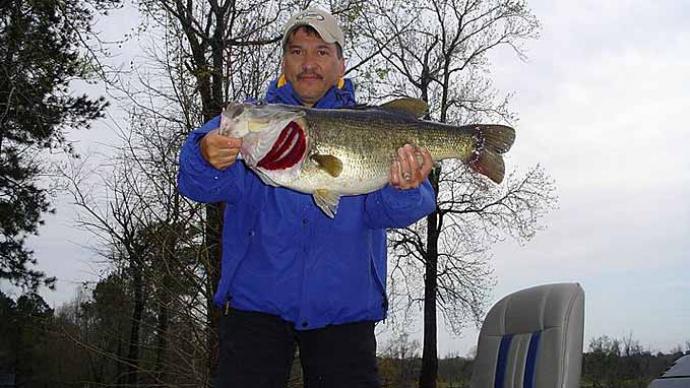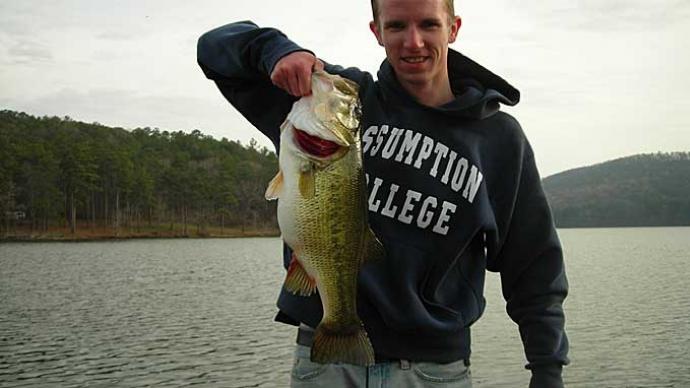
Santa has come and gone. Waterfowl season is over. The Super bowl is in the bag. Work is still a drag and the weekends are now offering little promise. What's a person to do? Baseball doesn't fire up until late March and your better half is pushing you to clean that darn garage and start prepping the house for painting this spring! Frankly, it sounds to me like it's time to rip the cover off the boat, hitch the trailer to the truck, and hit the lake!
Too cold you say? Nonsense. Grab those winter coveralls, pour a hot thermos of coffee and get to it man! This transitional period between the cold water temperatures found during the winter months and the not-too-far-off warming of spring can provide anglers with some red-hot action provided they know how to read the waters they are fishing. In an effort to fill the void in your weekends and keep you from applying that second coat of all-weather latex paint to the kitchen, I offer up these prespawn bassin' strategies and tips.
The Fish
Mother Nature has placed wintertime bass into a retarded animation. The cold water has slowed all bodily functions to a minimum including digestion and the urge to feed. These winter bass are typically found schooled in deeper oxygen-rich water. These fish are smart enough only to expend energy less than or equal to the amount of caloric intake they will derive from the food they consume. This is why your typical wintertime fish are taken on slower-moving worms, jigs, and spoons as opposed to reaction-baits fished at a faster pace.
However, a change occurs once the water temperatures start to rise. The warming water allows the fishes' metabolic rate to start slowly increasing. Bass become more active and start to move out of the deeper water in search of food. They typically travel along established transitional routes which lead up to shallower flats. This transitional period, which occurs from the cold of winter to the spawn, is called the prespawn.
The Prespawn
There is no specific time period or water temperature at which the prespawning activities occur, rather they occur over a range of times and temperatures. This is nature's way of protecting the species against radical environmental swings by having fish enter the prespawn and spawning modes at different times, temperatures, water levels, and water clarities. Generally speaking however, smallmouth bass will exhibit prespawn characteristics in waters ranging from 50 to 58 degrees, while largemouths will do the same in water temperatures ranging from 55 to 63 degrees.
The prespawn period is marked by a number of changes in the physiology of the bass as it enters the beginning of the spawning cycle. These are all changes that are working to the angler's advantage. As both an avid hunter and fisherman, I can draw a similarity between, bass behavior during the prespawn and rutting behavior seen in animals. Just like a Tom turkey chasing hens, or a buck in the rut, a bass will throw caution to the wind and go against its instinctual cautious behavior in pursuit of food, a partner, and a spawning site. Add to this the aggressive, protective nature of bass in guarding their beds during the spawn, and you have every angler's dream—a hungry, horny, & aggressive fish! Kinda reminds me of my college years.
Prespawn Strategies
As previously mentioned, the bass are actively moving from deep to shallower water and back, a few times each day to feed. They are largely consuming energy-rich foods such as crawdads and baitfish that will help provide the protein needed for milt & egg production. One of the first approaches the bass angler should take when fishing the prespawn is to pick up an accurate topographical map of the body of water they're fishing. Even an angler who has fished a lake several times can glean new details that are not obvious from shoreline geology by simply reviewing a topo map.
Prespawn anglers should key-in on areas which provide structure running from 40 to 50 feet of water into shallow areas of 15 feet or less that offer the bass a marked migratory route from the depths into shallow spawning areas. Look for areas that have trees, pilings, stumps, rock piles, or other debris running shallow to deep. With our large number of Western man-made impoundments, fence lines and old roads—flooded during the filling of the reservoirs—also make for ideal prespawn migratory routes.
Another key is to become familiar with the forage foods in the lake. Even though you know that the lake may have a good supply of shad or crawfish, try to find out the approximate size and coloration of the bait so that you can match these offerings as closely as possible in your lure selection. Some of the California lakes that stock trout heavily will experience a good bite on giant trout lures during prespawn months, as the larger females try to bulk up for the spawn.
Baits
Various baits will catch fish during prespawn months, but without a doubt, the deadly duo tends to be worms and jigs. Early prespawn bass are hungry and are primarily in a feeding mode. As the prespawn progresses into the spawn and postspawn periods, bass will tend to hit more out of a reactionary and aggressive stance. Your overall best bet for prespawners is to appeal to their "feeding mode" with slower-moving lures such as bottom-crawling worms and jigs. Remember, the water is still cold and all that is in it is still moving at a slower pace. Slow your retrieve down!
One of my favorite baits to fish during the prespawn is a small craw. These soft plastic scent-impregnated crawdad representations come in two sizes and a wide variety of colors, making it easy to match the craws in whatever body of water you happen to be fishing. They can be fished in a variety of ways, but the most common (and one I prefer for these baits) is the Texas rig.
I will also tend to use a fair amount of 6- to 7-inch worms during the prespawn period. Again, crawdad colors such as brown with a black stripe, brown with a blue core, hot chocolate, pumpkinseed, etc. are first choices during the prespawn. I will also treat my worms with Hot Sauce to ensure a good scent trail. If you don't like to use scents, I would highly recommend using Berkley Power Worms for this type of fishing. Hook size and the amount of weight you use will vary according to the size of bait, and overall water conditions you're fishing in. Use enough weight to keep in contact with the bottom. Crawdads are noisy creatures and you want your bait to make noise as you drag it along. Additionally, if you cannot easily distinguish the bottom, you will not be able to tell when you are bit.
Another solid choice for prespawn bass is the jig and pig combo. Of course, jig size and color will be determined by fishing conditions, but I'll usually opt for a 3/8-to 1/2-ounce stand-up or football-head brown or purple fine living rubber jig. I'll then tip this off with an Uncle josh #11 or #101 pork frog trailer. Although pork is a pain to work with, it offers some advantages that cannot be found with plastic trailers. Nothing has a more natural feel or is as durable as pork. Additionally, pork's ability to hold scents and float off the bottom gives it a natural look and smell that presents a more realistic offering to the fish.
Did anyone catch that I just mentioned "floating" pork? This is an important little trick that applies to all bottom jig fishing. I'll buy my Uncle Josh pork in the "Pint-o-Pigs" size, containing 28 baits in the #11 or 35 baits in the #101 size. I'll take the baits out and throw them into a bowl of fresh water. The baits that float are the ones I'll keep and fish, the rest I'll usually give away to the kids on the block who fish. Why? When fishing a jig, you want the claws of the pork trailer to float, not drag on the bottom. Crawdads don't drag their claws on the bottom and typically raise them upward when in a defensive position. This is why "floating" pork is important for realism in jig and pig fishing.
I have also been successful with prespawn bass by fishing large crankbaits such as the BooYah #7 Fat Free Shad or the Bill Norman DD22N crankbaits in both shad and crawdad patterns. These baits—when fished slowly—will let you cover more water than fishing with bottom-crawling baits. However, once I locate the fish, I will typically switch over to a worm or jig, and cover the area with a slower, more methodical approach. I prefer to use suspending models as they will stay in the strike zone better during your slower retrieves than their floating counterparts.
There is no hard and fast rule as to what bait to use other than to say that fish are in feeding modes during the prespawn. Slow your retrieve down and work at various depths along the migratory structure you're fishing. These fish are on the move so you will need to try to work up and down the cover until you hook-up.
Tackle
Good prespawn gear will consist of almost anything you are comfortable fishing, but I would strongly recommend a high-modulus graphite rod so help you feel everything that is going on below. Jig and worm fishing is contact fishing and if you can't feel your bait, you often cannot feel the fish during subtle or pressure bites. I prefer to use a Lamiglas 6 1/2-foot medium heavy action rod. I'll use either a Shimano Calais or Daiwa reel filled with 10- to 15-pound P-Line CXX green monofilament. The line weight varies depending upon water clarity and the nature of the structure that I am fishing. I'll throw the 15-pound line when using heavier jigs or worms around trees and dense structure.
For large crankbaits, I'll use the Lamiglas 7 1/2-foot Crank N Blade filled with 12-pound P-Line CXX Green on a Shimano Curado 5:1 gear ratio reel. The slower gear ratio forces you to slow down your retrieve and although this isn't tuna fishing, the lower gear ratio actually gives you more leverage on bigger bass. It also keeps from wearing you out as the higher retrieve reels will offer a lot of mechanical resistance as you try to retrieve one of the big billed cranks. The lower gear ratio reels will keep you from tiring out.
Clothing
Here in the West, we are fortunate to have temperate weather for most of our early bassing season. This, however, is not always the case. Dressing properly for a cold day on the lake is a must. Winter and prespawn bass usually do not hit with the same voracity as other times of the year. Your ability to concentrate on your subtle-bite fishing is shot to heck if you are cold, shivering, and thinking how nice it would be to be sitting in the cafe back at the launch ramp sipping hot chocolate.
Dressing appropriately is a must. A good set of coveralls or snowmobile suit are a necessity and will protect you from chilling runs across the lake. A set of half-finger wool gloves and heavy trooper-style hat can be inexpensively purchased at the local surplus store. The main thing to remember is if you have it, you can always take it off, but if you don't have it, you can't put it on! You have most likely traveled a few hours to your fishing destination, so be sure you are properly prepared to spend the day on the lake regardless of the weather.
Just remember, prespawn bass fishing will require a little more preparation and homework in terms of locating fish holding along migratory routes from the depths to the shallow spawning areas. Armed with this new knowledge, we now leave you with two choices: get out and get your line wet, or start looking through the Sunday papers for the best price on that one-coat exterior latex house paint.
Reprinted with permission from Bass West Magazine




